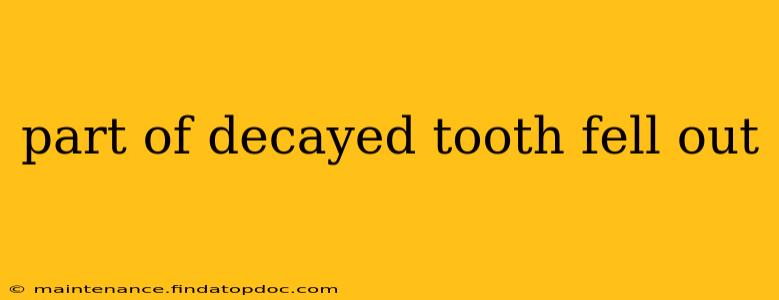Discovering a chunk of your decayed tooth missing is alarming, but it's a common dental emergency. This situation requires prompt attention to prevent further damage and potential complications. This guide will walk you through the immediate steps to take, potential causes, and when to seek professional dental care.
What Causes Part of a Decayed Tooth to Fall Out?
The most common culprit is dental caries, better known as tooth decay. This occurs when bacteria in your mouth produce acids that erode tooth enamel and dentin, the hard layers protecting your tooth's pulp (the inner soft tissue containing nerves and blood vessels). Over time, this erosion weakens the tooth structure, making it prone to breakage and fracturing. Other contributing factors include:
- Untreated cavities: Neglecting cavities allows the decay to progress, ultimately leading to tooth loss.
- Aggressive brushing: While brushing is crucial, overly vigorous brushing with a hard-bristled toothbrush can abrade tooth enamel, increasing vulnerability.
- Teeth grinding (bruxism): This habit puts significant stress on teeth, leading to cracks and fractures.
- Trauma: An accidental injury to the mouth can chip or break a weakened tooth.
- Dental procedures: Sometimes, a portion of a decayed tooth might be removed during a dental procedure like a filling or root canal.
What Should I Do If Part of My Decayed Tooth Fell Out?
Immediate action is vital. Here's what you should do:
- Rinse your mouth gently: Use warm salt water to clean the area and remove any debris. Avoid aggressive rinsing.
- Locate the missing piece (if possible): If you can safely retrieve the broken piece, store it in a container of milk or saline solution. This may be useful for your dentist.
- Apply pressure (if bleeding): If you're experiencing bleeding, apply gentle pressure to the area with a clean gauze pad or cloth.
- Avoid eating or drinking on that side of your mouth: To prevent further irritation and potential infection.
- Contact your dentist immediately: Schedule an appointment as soon as possible for assessment and treatment.
How Will My Dentist Treat a Broken Decayed Tooth?
Treatment depends on the extent of the damage and the condition of the remaining tooth structure. Your dentist might recommend:
- Filling: If the decay is limited and the tooth structure is strong enough, a filling might be sufficient to restore the tooth's shape and function.
- Crown: If a significant portion of the tooth is missing or the remaining structure is weakened, a crown (a cap placed over the tooth) is often necessary to protect it.
- Root canal: If the decay has reached the pulp, a root canal might be required to remove the infected tissue and prevent further infection.
- Extraction: In severe cases where the tooth is beyond repair, extraction (removal of the tooth) may be the only option.
Is it Painful When Part of a Decayed Tooth Falls Out?
The level of pain varies considerably depending on the individual and the extent of the decay. Some people experience minimal discomfort, while others might feel significant pain. If the decay has reached the pulp, you're likely to experience more intense pain.
Can I Fix a Broken Tooth Myself?
No. Attempting to fix a broken tooth at home is strongly discouraged. Improper attempts at repair can worsen the damage, increase the risk of infection, and delay professional treatment. Only a dentist has the expertise and tools to properly address a broken tooth.
How Can I Prevent Tooth Decay?
Preventive measures are crucial for maintaining healthy teeth. Here are some tips:
- Practice good oral hygiene: Brush your teeth twice daily with fluoride toothpaste and floss daily.
- Maintain a healthy diet: Limit sugary foods and drinks.
- Regular dental checkups: See your dentist for regular checkups and cleanings to detect and treat cavities early.
Remember, seeking professional dental care is paramount. Don't delay seeking help if part of your decayed tooth has fallen out. Early intervention can often prevent more extensive damage and costly procedures. Your dentist is the best resource for diagnosis and treatment.
